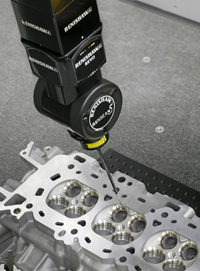Navigation
Valve seat inspection

The measurement of valve seats and guides has traditionally been very challenging, involving time-consuming methods that are often a compromise and not capable for the task.
REVO technology changes this situation dramatically, making it possible to collect large amounts of data very quickly, from which the analysis parameters for both the valve seat and the valve guide features can be calculated. The method performs exceptionally well in repeatability and reproducibility tests.
Data evaluation
The valve seat and guide analysis utility that is embedded in Renishaw's MODUS metrology software is utilised to evaluate the scan data and return data regarding the attributes listed below:-
- Form error of the valve seat
- Circularity profile of the seat at any specified height
- Valve seat width
- Runout of the seat to the guide bore axis
- Diameter of the guide
- Straightness of the guide cylinder
- Cylindricity of the guide
- Circularity profile of the guide cylinder at any specified height
- Form errors of the cones, above and below the valve seat cone
The two types of scanning used to inspect valve seats and guides are...
Helical scans
The measurement process involves two helical scans, one on the valve guide bore and the second over the valve seat area.
On the guide a single helical scan is used with a typical pitch of 0.5 mm, at a scanning speed of 150 mm/s.
Adaptive scanning
This valve seat scan utilises REVO's adaptive scanning capability, which allows a single scan command to cover the areas above and below the critical valve seat surfaces.
On the valve seat a single helical scan is also used, with a typical pitch of 0.1 mm, at a scanning speed of 500 mm/s.
THE DATA COLLECTION PROCESS TAKES APPROXIMATELY 20 SECONDS!

| Part number | |
| MODUS online | |
| MODUS - touch-trigger (IGES input, STEP input, collision detection, MODUS organiser) | A-5639-0001 |
| MODUS - 3-axis scanning (IGES input, STEP input, collision detection, MODUS organiser) | A-5639-0003 |
| MODUS - 5-axis scanning (IGES input, STEP input, collision detection, MODUS organiser) | A-5639-0005 |
| MODUS offline | |
| MODUS - touch-trigger offline | A-5639-0101 |
| MODUS - 3-axis scanning offline | A-5639-0103 |
| MODUS - 5-axis scanning offline | A-5639-0105 |
| MODUS options | |
| MODUS airfoil | M-5639-0008 |
| MODUS point cloud sectioning (MPCS) | M-5639-0225 |
| MODUS surface texture | M-5639-0226 |
| MODUS surface texture advanced | M-5639-0227 |
| MODUS gear | M-5639-0215 |
| MODUS spline | M-5639-0216 |
| MeasureMax client | M-5639-3500 |
| MODUS upgrades | |
| MODUS touch-trigger to 3-axis scanning upgrade | A-5639-5001 |
| MODUS touch-trigger to 5-axis scanning upgrade | A-5639-5002 |
| MODUS 3-axis scanning to 5-axis scanning upgrade | A-5639-5003 |
| MODUS CAD options | |
| VDA-FS import / export | M-5639-0010 |
| CATIA V4 import | M-5639-0020 |
| CATIA V4 import / export | M-5639-0021 |
| CATIA V5 import | M-5639-0022 |
| CATIA V5 import / export | M-5639-0023 |
| CATIA V5 manufacturing option (includes CATIA V5 import) | M-5639-0024 |
| Unigraphics import | M-5639-0030 |
| Unigraphics manufacturing option (includes Unigraphics import) | M-5639-0031 |
| Parasolid import / export | M-5639-0032 |
| Pro/E import | M-5639-0040 |
| Pro/E manufacturing option (includes Pro/E import) | M-5639-0041 |
| SolidWorks import | M-5639-0050 |
| MODUS educational | |
| Education bundle 1 (5 seats, maintenance contract required) | A-5639-0251 |
| Education bundle 2 (10 seats, maintenance contract required) | A-5639-0252 |
| Education bundle 3 (20 seats, maintenance contract required) | A-5639-0253 |
| MODUS maintenance | |
| MODUS - touch-trigger | M-5639-0501 |
| MODUS - 3-axis scanning | M-5639-0503 |
| MODUS - 5-axis scanning | M-5639-0505 |
| MODUS - touch-trigger offline | M-5639-0601 |
| MODUS - 3-axis scanning offline | M-5639-0603 |
| MODUS - 5-axis scanning offline | M-5639-0605 |
| MODUS airfoil | M-5639-0508 |
| MODUS point cloud sectioning (MPCS) | M-5639-0725 |
| MODUS surface texture | M-5639-0726 |
| MODUS surface texture advanced | M-5639-0727 |
| MODUS gear | M-5639-0715 |
| MODUS spline | M-5639-0716 |
| VDA-FS import / export | M-5639-0510 |
| CATIA V4 import | M-5639-0520 |
| CATIA V4 import / export | M-5639-0521 |
| CATIA V5 import | M-5639-0522 |
| CATIA V5 import / export | M-5639-0523 |
| CATIA V5 manufacturing option (includes CATIA V5 import) | M-5639-0524 |
| Unigraphics import | M-5639-0530 |
| Pro/E manufacturing option (includes Pro/E import) | M-5639-0531 |
| Parasolid import / export | M-5639-0532 |
| Pro/E import | M-5639-0540 |
| Pro/E manufacturing option (includes Pro/E import) | M-5639-0541 |
| SolidWorks import | M-5639-0550 |
| Educational bundle 1 annual maintenance | M-5639-0751 |
| Educational bundle 2 annual maintenance | M-5639-0752 |
| Educational bundle 3 annual maintenance | M-5639-0753 |
| APEXBlade | |
| APEXBlade (stand-alone licence) | A-5639-0220 |
| APEXBlade (add-on to existing MODUS licence) | M-5639-0220 |
| APEXBlade maintenance | M-5639-0720 |
| SurfitBlade | |
| SurfitBlade (stand-alone licence) | A-5639-0221 |
| SurfitBlade (add-on to existing MODUS licence) | M-5639-0221 |
| SurfitBlade maintenance | M-5639-0721 |